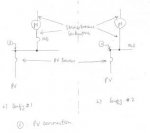fandi
Senior Member
- Location
- Los Angeles
- Occupation
- Electrical Engineer
Hello All,
(Under NEC 2014) Would a PV connection (via a PV breaker) to an existing MLO panel considered a supply side connection? (To me it's a load side connection because the PV breaker takes one of the MLO panel's feeder breaker slots)
And if it's not a supply side connection, would this following configuration comply with 705.12(D)(2)(3)(a)?
48A output inverter connects to a 100A MLO panel via a 60A PV breaker.
125% x 48A + 0A <=100A.
Assumptions:
- Manufacturer cutsheet of that MLO panel allows PV system to connect to the panel via a PV breaker.
- the total breakers (PV breaker plus all existing feeder breakers) are no greater than 6.
Also, if it's a load side connection, is there any of the 705.12 section requires the service panel has to have a main breaker in order for the PV system to hook up? I see that NEC 2014 705.22 only requires a disconnect device at the main service panel, not a OCPD. Meaning an external disconnect ahead of the MLO panel would suffice.
Thanks.
(Under NEC 2014) Would a PV connection (via a PV breaker) to an existing MLO panel considered a supply side connection? (To me it's a load side connection because the PV breaker takes one of the MLO panel's feeder breaker slots)
And if it's not a supply side connection, would this following configuration comply with 705.12(D)(2)(3)(a)?
48A output inverter connects to a 100A MLO panel via a 60A PV breaker.
125% x 48A + 0A <=100A.
Assumptions:
- Manufacturer cutsheet of that MLO panel allows PV system to connect to the panel via a PV breaker.
- the total breakers (PV breaker plus all existing feeder breakers) are no greater than 6.
Also, if it's a load side connection, is there any of the 705.12 section requires the service panel has to have a main breaker in order for the PV system to hook up? I see that NEC 2014 705.22 only requires a disconnect device at the main service panel, not a OCPD. Meaning an external disconnect ahead of the MLO panel would suffice.
Thanks.
Last edited:


